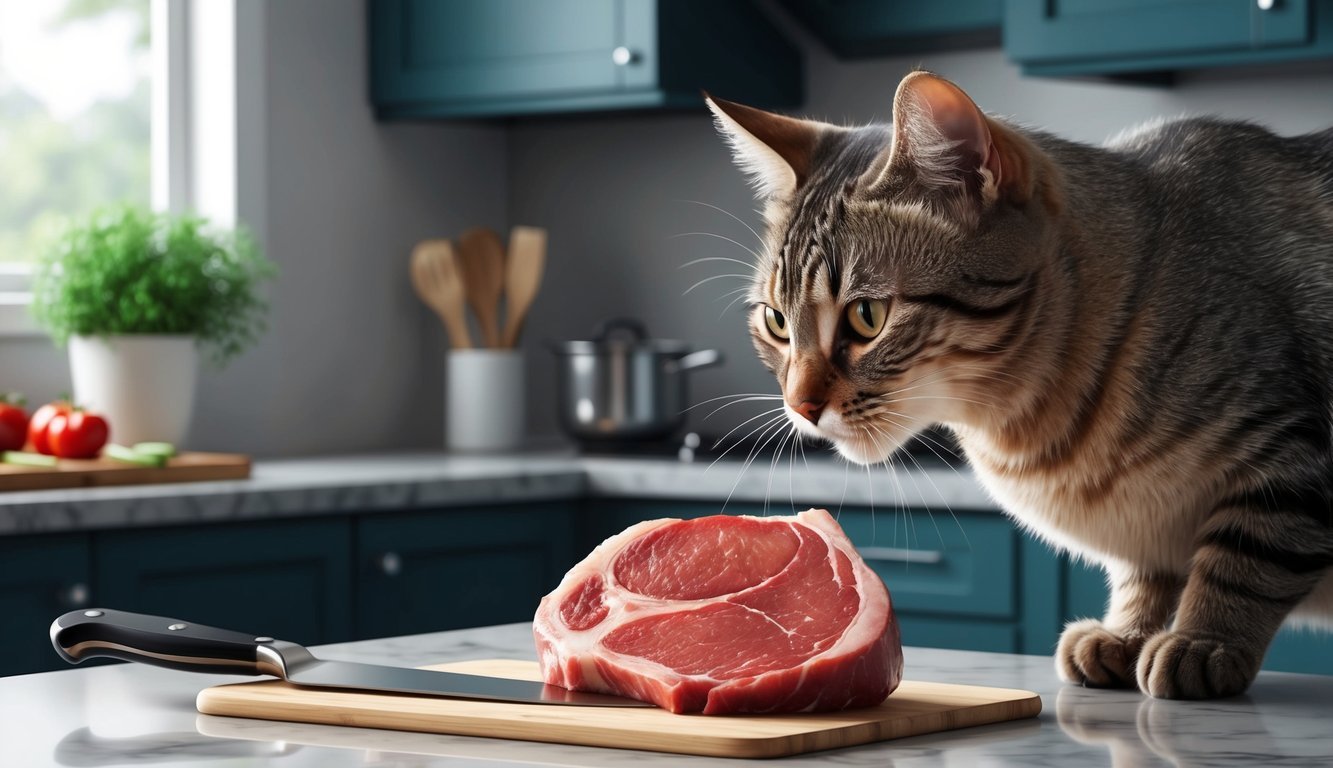If you’ve ever wondered whether your feline friend can safely enjoy a taste of raw pork, you’re not alone.
Many cat owners find themselves navigating the complexities of their pet’s dietary needs, especially with the growing popularity of raw food diets. Cats can technically eat raw pork, but it’s essential to be aware of the potential risks involved.
Feeding your cat raw meat can carry health concerns due to pathogens that may be present.
While some cats adapt well to raw diets, it’s important to strike a balance and ensure they receive all necessary nutrients.
Understanding your pet’s needs helps you make informed decisions about their diet and well-being.
As you consider your cat’s meals, knowing the ins and outs of feeding raw pork can be key.
Not only will you learn about safe preparation methods, but you’ll also discover alternative food options that meet your cat’s nutritional requirements without the risks that come with raw meat.
Key Takeaways
- Cats can eat raw pork, but caution is advised due to health risks.
- It’s vital to provide a balanced diet to meet all nutritional needs.
- Alternatives to raw pork exist that can keep your cat healthy and happy.
Understanding a Cat’s Dietary Needs
A well-balanced diet is crucial for your cat’s health.
Knowing what makes up their natural diet helps you provide the best nutrition.
Key elements include their status as obligate carnivores and the essential nutrients they need.
Obligate Carnivores and Natural Diet
Cats are obligate carnivores, meaning their biology requires a diet primarily made up of meat.
This is essential for their health and contributes to their energy levels and overall well-being.
Unlike other animals that can thrive on a plant-based diet, cats need animal protein to meet their nutritional needs.
In the wild, a cat’s diet consists of small prey, including birds and rodents.
These animals provide not just protein, but also fat and other vital nutrients.
When choosing cat food, look for options that reflect this natural diet and include high protein content sourced from meat.
Nutritional Components Essential for Cats
Certain nutrients are non-negotiable for your feline friend.
Taurine, for example, is an amino acid found in animal tissue and is crucial for heart, eye, and reproductive health.
Cats cannot produce enough taurine on their own, so it should be included in their diet.
Other essential components include high-quality protein, essential fatty acids, vitamins, and minerals.
A proper balance supports their immune system and aids in digestion.
Foods that lack these key nutrients can lead to health problems, making it important to choose quality cat food or suitable treats like lean meats when considering options like pork.
Potential Risks of Feeding Cats Raw Pork

Feeding your cat raw pork may seem like a natural choice, but it comes with several health risks.
Understanding these dangers is essential for any pet parent considering this option for their feline friends.
Bacterial Hazards in Raw Meat
Raw pork poses significant risks due to harmful bacteria like salmonella and listeria.
These pathogens can lead to food-borne illnesses not only in humans but also in your cat.
If your cat consumes contaminated pork, symptoms may include vomiting, diarrhea, and lethargy.
To minimize the risks, ensure proper handling and hygiene during food preparation.
Always wash your hands and sanitize surfaces after contact with raw meat.
Cooking pork thoroughly kills harmful bacteria, so it’s essential to weigh the risks if you decide to serve raw.
Parasites and Raw Pork
Raw pork can also harbor parasites that pose a risk to your cat’s health.
One notable concern is trichinosis, caused by the parasite Trichinella, which can thrive in undercooked or raw pork.
While the incidence of trichinosis in pork has decreased over the years, it still exists.
Symptoms in cats may include gastrointestinal upset and, in severe cases, muscle inflammation.
Proper cooking destroys these parasites, making cooked pork a safer option for your cat.
By understanding the risks, you can make informed decisions about your pet’s diet.
High Fat Content and Feline Health
Pork is generally higher in fat compared to other meats.
A high-fat diet can lead to obesity and related health issues in cats, including heart problems and diabetes.
If you choose to feed your cat pork, monitor portion sizes.
Additionally, consider the fat content of other foods in their diet.
Pancreatitis is another concern related to high-fat consumption.
This inflammation of the pancreas can cause severe pain and require veterinary intervention.
Being aware of your cat’s dietary needs can help you maintain their health while being attentive to the risks associated with feeding them raw pork.
Raw Diets Versus Cooked Diets
Choosing between a raw diet and a cooked diet for your cat can be a pivotal decision.
Each option comes with its own set of benefits and risks, especially when it comes to feeding raw pork.
Benefits of Raw Meat Diets
A raw meat diet aligns closely with your cat’s natural needs as obligate carnivores.
Cats evolved to consume raw animal products, which provide essential nutrients more efficiently than cooked options.
Health Benefits Include:
- Better Digestion: Raw food is easier on your cat’s digestive system, potentially reducing instances of upset stomach or diarrhea.
- Enhanced Nutrient Absorption: Nutrients are more bioavailable in raw meat, promoting better overall health.
- Improved Coat Condition: Many cat owners report shinier coats and healthier skin with raw diets.
While raw diets can offer these benefits, it’s crucial to ensure that the diet is balanced to avoid nutritional deficiencies.
When is Pork Safe for Cats to Eat?
Feeding raw pork to cats can be contentious due to potential food-borne illnesses.
While cats can digest raw pork, it carries risks like trichinosis and other pathogens.
Consider these tips before offering pork:
- Source Quality: Always select high-quality pork from reputable suppliers to minimize risks.
- Freeze Before Serving: Freezing pork can kill harmful parasites but does not eliminate bacteria. Make sure to freeze for at least three weeks.
- Balance with Other Proteins: Incorporating various protein sources, such as chicken or fish, helps offset the risks associated with any single meat type.
By following these guidelines, you can enjoy peace of mind when adding pork to your cat’s diet.
Preparing Pork for Your Cat
When considering pork for your cat, safe preparation and proper handling are crucial.
Understanding how to manage raw meat and consulting an expert can help ensure your pet’s health and well-being.
Proper Handling of Raw Meat
Handling raw pork safely is essential to minimize health risks.
Always wash your hands thoroughly before and after touching raw meat.
Use separate cutting boards for meat to avoid cross-contamination with other foods.
Remove bones, which can splinter and cause choking hazards or internal injuries.
Also, eliminate excess fat, as high-fat content may lead to pancreatitis in cats.
Store raw pork in airtight containers in the refrigerator and use it within one to two days.
If you don’t plan to use it soon, consider freezing it.
Remember, never leave raw meat out at room temperature, as bacteria can multiply quickly.
Consulting a Veterinary Nutritionist
Before adding raw pork to your cat’s diet, consider consulting a veterinary nutritionist.
They can provide tailored advice, ensuring that pork fits into your cat’s overall dietary needs.
This is especially important, as cats are obligate carnivores and require a balanced diet.
Ask your vet about the proper portions and frequency for pork treats.
Keep in mind that processed pork products, such as sausages or bacon, often contain seasonings and preservatives that are not safe for cats.
Your vet can guide you on the best practices for incorporating pork in a way that maintains your cat’s health.
Alternatives to Raw Pork in a Cat’s Diet

If you’re considering alternatives to raw pork for your cat, there are several safe and nutritious options.
High-Quality Cat Food:
Choose a balanced cat food that meets your cat’s nutritional needs.
Look for brands that list meat as the main ingredient.
This ensures your cat gets the protein they require without the risks associated with raw meat.
Cooked Meats:
You can offer cooked chicken, turkey, or beef.
Make sure these meats are plain, without any seasoning, bones, or skin.
Cooked meats are safe and can be a delicious treat for your cat.
Processed Pork Products:
While processed pork products like bacon should be avoided, small amounts of lean, cooked pork without additives can be given occasionally.
Always prioritize moderation to prevent health issues.
Fish:
Tuna or salmon can be enticing and are often safe for cats.
Again, these should be cooked and free of any seasoning.
Just remember to limit fish consumption, as too much can lead to mercury exposure.
Wet Cat Food:
Consider wet cat food that is high in moisture content.
This helps keep your cat hydrated while providing essential nutrients.
By offering these alternatives, you can ensure your cat’s diet remains healthy and balanced without the risks associated with raw pork.
Frequently Asked Questions
You might have some questions about feeding raw pork to your cat.
It’s important to understand the safety concerns and potential health impacts associated with this practice.
Here are some common queries that many cat owners have.
Is it safe for cats to eat raw pork?
Feeding raw pork to cats is risky.
While cats can digest raw meat, pork can carry harmful bacteria and parasites, leading to serious health issues.
It’s advised to avoid giving your cat raw pork to ensure their safety.
What should I do if my cat eats raw pork by accident?
If your cat consumes raw pork by accident, monitor them closely for any signs of illness, such as vomiting or diarrhea.
It’s best to consult a veterinarian for advice on potential risks and whether any treatment is necessary.
Can feeding my cat raw pork cause any health issues?
Yes, feeding raw pork can lead to several health issues, including food poisoning caused by bacteria like salmonella and listeria.
Additionally, there’s a risk of trichinosis, a parasitic disease associated with raw pork that can be harmful to your cat.
Are raw pork bones dangerous for cats to chew or eat?
Raw pork bones can be dangerous for cats.
They may splinter easily, posing a choking hazard or causing injuries to the mouth and digestive tract.
Always supervise your cat if you decide to offer any bones and consider safer alternatives.
Can I give my cat other raw meats besides pork?
While some cat owners choose to feed raw meats, not all are safe.
It’s crucial to familiarize yourself with the risks associated with each type of meat before offering them to your cat.
Always consult your vet for tailored recommendations.
What meats are considered safe for cats to consume raw?
Some safe options for raw meat include chicken, turkey, and certain types of fish.
However, make sure they are fresh and sourced from reliable suppliers.
Also, make sure to follow guidelines for preparation to minimize any health risks for your cat.


